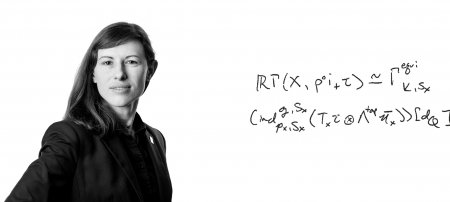Like Lego bricks or spaghetti, composites modeling is about scale, ingredients and fitting the right blocks together.
Sure, they’re mixed metaphors — but just as modeling is a close estimate of real-world processes, so too are verbal explanations of such nuanced arithmetic. Trisha Sain, assistant professor of mechanical engineering, explores multiscale physics by thinking about the Lego bricks in her living room, the windows of skyscrapers and cooking a feast.
Before we drain our noodles, let’s lay some foundation for the study of composite materials. Composites are made of multiple materials that combine different mechanical and chemical properties, and ideally such microstructure combinations are a win-win for maximizing desired properties. But combinations create more complexity, especially when they are exposed to extreme environments.
About the Researcher
For example, Sain’s research looks at fiber-reinforced polymer composites for the U.S. Air Force. The materials have to withstand wet, heat, cold and maybe a few blasts. “These materials can handle such extremes,” she said. “The problem is that, like all materials, they age. We study that degradation.”
Composites Pasta
Which brings us back to spaghetti. Sain said understanding the behavior of composites and how they react to wind, rain, cold and other environmental factors is like untangling a bowl of spaghetti noodles. Polymers, which are long carbon chains, wrap and twist around much like cooked pasta. While the specific chemistry and mechanical properties of composites are well-known, Sain wants to know what happens when the noodles meet sauce: how the polymers interact with environmental factors such as air or heat or their absence.
And, much like we don’t order a dish of “noodles-tomatoes-basil-and-oregano” in a restaurant, composites in the real world are not used or assessed by their microstructural ingredients. To understand composites spaghetti, Sain studies the dish as a whole — testing each material on multiple scales and prototyping whole pieces of equipment. To model how these materials degrade over time, she must put together a whole feast of calculations — from the noodles of a polymer’s chains, to the plate of a panel, to the buffet of a whole machine.
“So, our objective is to capture the right physics at each scale and transfer the information from one length scale to another in a consistent way,” Sain said. Doing so requires a kind of mathematical homogenization called “on-the-fly” calculations, she explained. “Can we capture these characteristics with a modeling framework that traverses smoothly across one scale to another? Because it’s not just a different length scale; it’s different physics, and each of these physical processes might occur on a different time scale.”
Architecture of Composites Modeling
Another way Sain explains how her models span multiple scales is to think of Lego bricks. The blocks fit together in specific ways, and some fit together better than others depending on the design.
“But if you try to make a whole campus building out of Legos, you’re going to have problems,” Sain said. At bigger scales, the physics and material behavior change. In terms of model architecture, on-the-fly homogenization enables the model’s calculations to shift from tallying windowsills, to viewing the window, to then accounting for the whole wall with all of its windows. By comparison, simpler discrete models have to use hard boundaries between sill/window/wall calculations.
“Basically, our objective was not to rapidly cut the scales and instead continuously traverse them,” Sain said. “We are doing a statistical mechanical systems approach within the polymer length scale — the window length scale — but still trying to keep in mind that the statistical and mechanical descriptions of whatever we calculate have to be applicable at the larger length — the wall scale.”
Such graceful glides between scales, regardless if the material is noodle-y, plastic, glass-paned or fiber-reinforced, enable Sain to predict and assess composite degradation with more ease and less money than traditional experiments.
Michigan Technological University is an R1 public research university founded in 1885 in Houghton, and is home to nearly 7,500 students from more than 60 countries around the world. Consistently ranked among the best universities in the country for return on investment, Michigan's flagship technological university offers more than 185 undergraduate and graduate degree programs in science and technology, engineering, computing, forestry, business, health professions, humanities, mathematics, social sciences, and the arts. The rural campus is situated just miles from Lake Superior in Michigan's Upper Peninsula, offering year-round opportunities for outdoor adventure.







Comments